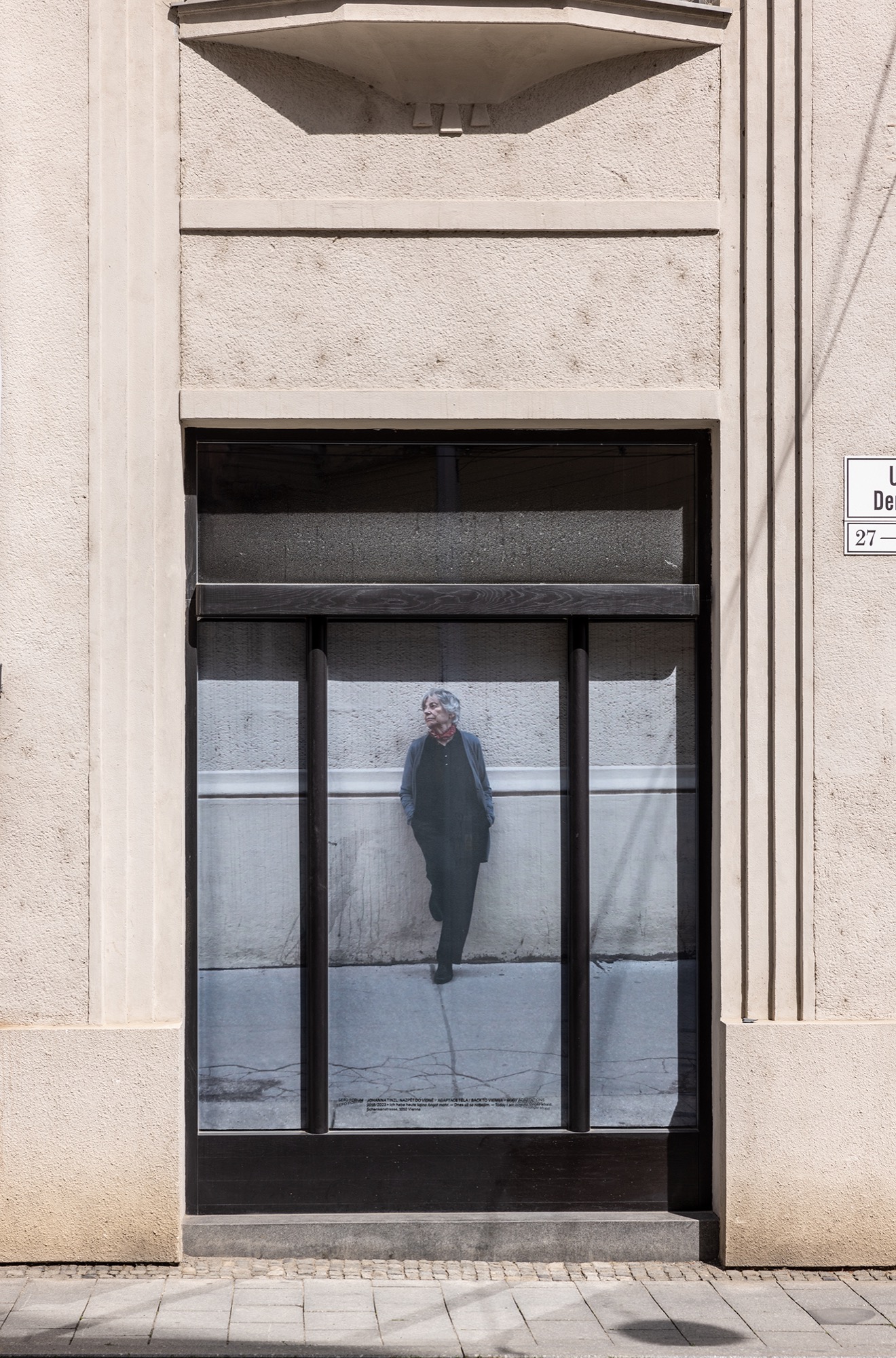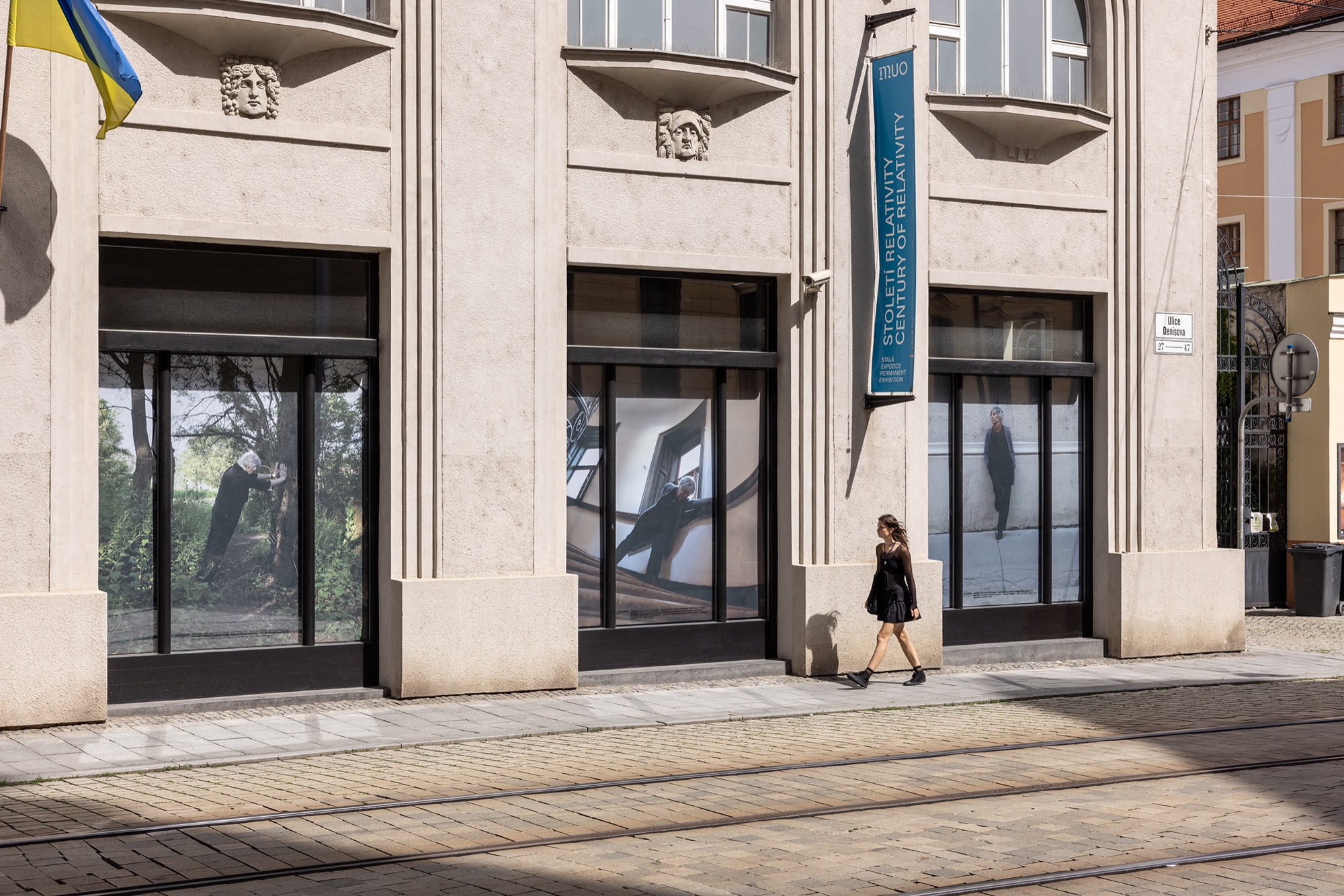2023/2016 ︎
Back
in Vienna – Body Adaptations in Public Space︎
Intervention︎Three
large-format posters from a series of 9 photographs︎2,4 m x 2,4 m︎Muzeum umění, Olomouc (CZ)







Back in Vienna – Body Adaptations in Public Spaces
Intervention, Muzeum umění, Olomouc (CZ)
Three large-format posters from a series of 9 photographs, 2016/2023
2,4 m x 2,4 m
The
large-format photographic triptych – created by the artist's
selection from an original set of nine images depicting Helga
Pollak-Kinsky – brings the themes of Pollak-Kinsky's turbulent life
to the Olomouc public, and thus also returns her imaginatively to the
framework of the wider Central Europe. Tinzl captured Pollak-Kinsky
in Vienna, at places that were crucial to her life – both before
her escape from Austria in 1938 to the Moravian town of Kyjov, or
deportation to Theresienstadt Ghetto, later to Auschwitz, and after
her return to the country in 1957.
Together with the author, she began to systematically revisit them, reliving her own memories and actual relationships and connections. Drawing inspiration from VALIE EXPORT’s photographic series »Body Configurations«, which was created between 1972 and 1976, Tinzl reflected on the presence and representation of the female body in the public space of the city and in society in general.
The work was presented in a public space version at the time of the global pandemic of COVID-19 in Vienna. While doing that, Tinzl also thematised the problem of ageing or its massive marginalisation in Western (post)capitalist society.
Text: Barbora Kundračíková
Photos: © Zdeněk Sodoma
Together with the author, she began to systematically revisit them, reliving her own memories and actual relationships and connections. Drawing inspiration from VALIE EXPORT’s photographic series »Body Configurations«, which was created between 1972 and 1976, Tinzl reflected on the presence and representation of the female body in the public space of the city and in society in general.
The work was presented in a public space version at the time of the global pandemic of COVID-19 in Vienna. While doing that, Tinzl also thematised the problem of ageing or its massive marginalisation in Western (post)capitalist society.
Text: Barbora Kundračíková
Photos: © Zdeněk Sodoma
EXCERPT
OF A CONVERSATION BETWEEN
BARBORA KUNDRAČÍKOVÁ AND JOHANNA TINZL
BK: Could you describe your intentions in working with Helga Pollak-Kinsky and how did your relationship develop when you approached more personal topics?
JT: I met Helga Pollak-Kinsky in 2010 when I was doing research together with the artist Stefan Flunger on Friedl Dicker-Brandeis and the concentration camp Theresienstadt. We started doing projects with Helga and her friends that focused on their extraordinary biographies as Holocoust survivors. Helga Pollak-Kinsky (born in 1930 in Vienna) was forced to emigrate as 8-year-old girl to Brno (CZ) respectively Kyjov (CZ). With her father and her relatives, she was deported to Theresienstadt in January 1943. Together with other children she visited the secret classes - including the drawing lessons with the artist Friedl Dicker-Brandeis who was also imprisoned in Theresienstadt. During her internment she wrote a diary in Czech which is the basis for the book »The Girls of Room 28: Friendship, Hope and Survival in Theresienstadt« (published by Schocken Books, New York, 2009). Helga Pollak was deported to Auschwitz in October 1944. Throughout the selection she was assigned to a group of women who were destined to do forced labor in Oederan in Saxony in an ammunition factory. With a misery transport she was deported back to Theresienstadt at the end of April 1945 where she and her father witnessed the liberation. After stopovers in Bangkok (Thailand) and Addis Abeba (Ethiopia) she lived again in Vienna where she passed away in 2020. Since 2010 Helga and I were connected by a growing friendship. We spoke regularly on the phone, I visited her at her home and she invited me to her official ceremonies, where she received late but still recognition of her work as a witness of the Holocaust. Mostly we would discuss day-to-day politics and remembrance work. Over the years we became friends and I still wondered how Helga must have felt when she came back to Vienna in 1957, to the city from which she was expelled by the Nazis in 1938. This question was the starting point for »Back in Vienna - Body Adaptations« which I started to develop together with her in 2015.
BK: How do you deal with these issues personally and professionally in general?
JT: Showing the work for the first time again after Helga’s passing and then in the Czech Republic of all places comes with great responsibility for me.
I can no longer ask Helga what she thinks about showing the nine photographs there where her father was born, there where she had been taken to safety in Brno and later to her extended family in Kyjov, and yet from where she had been caught by the Nazis and deported to the Theresienstadt concentration camp together with her father. The Czechoslovak Republic was also where most of Helga's relatives lived. 63 of them did not survive the Holocaust. If I had asked Helga, as I have for all previous presentations of »Back in Vienna - Body Adaptations«, whether I should do the exhibition, I'm sure she would have said, »Do it!«. Despite her terrible experiences, Helga Pollak-Kinsky has kept an open mind and love for people throughout her life. In this she will always remain my role model and I am grateful that I was allowed to become her friend!
BK: Do you think art has the power to change the world we live in?
JT: No. But I still hope for it for sure.
BARBORA KUNDRAČÍKOVÁ AND JOHANNA TINZL
BK: Could you describe your intentions in working with Helga Pollak-Kinsky and how did your relationship develop when you approached more personal topics?
JT: I met Helga Pollak-Kinsky in 2010 when I was doing research together with the artist Stefan Flunger on Friedl Dicker-Brandeis and the concentration camp Theresienstadt. We started doing projects with Helga and her friends that focused on their extraordinary biographies as Holocoust survivors. Helga Pollak-Kinsky (born in 1930 in Vienna) was forced to emigrate as 8-year-old girl to Brno (CZ) respectively Kyjov (CZ). With her father and her relatives, she was deported to Theresienstadt in January 1943. Together with other children she visited the secret classes - including the drawing lessons with the artist Friedl Dicker-Brandeis who was also imprisoned in Theresienstadt. During her internment she wrote a diary in Czech which is the basis for the book »The Girls of Room 28: Friendship, Hope and Survival in Theresienstadt« (published by Schocken Books, New York, 2009). Helga Pollak was deported to Auschwitz in October 1944. Throughout the selection she was assigned to a group of women who were destined to do forced labor in Oederan in Saxony in an ammunition factory. With a misery transport she was deported back to Theresienstadt at the end of April 1945 where she and her father witnessed the liberation. After stopovers in Bangkok (Thailand) and Addis Abeba (Ethiopia) she lived again in Vienna where she passed away in 2020. Since 2010 Helga and I were connected by a growing friendship. We spoke regularly on the phone, I visited her at her home and she invited me to her official ceremonies, where she received late but still recognition of her work as a witness of the Holocaust. Mostly we would discuss day-to-day politics and remembrance work. Over the years we became friends and I still wondered how Helga must have felt when she came back to Vienna in 1957, to the city from which she was expelled by the Nazis in 1938. This question was the starting point for »Back in Vienna - Body Adaptations« which I started to develop together with her in 2015.
BK: How do you deal with these issues personally and professionally in general?
JT: Showing the work for the first time again after Helga’s passing and then in the Czech Republic of all places comes with great responsibility for me.
I can no longer ask Helga what she thinks about showing the nine photographs there where her father was born, there where she had been taken to safety in Brno and later to her extended family in Kyjov, and yet from where she had been caught by the Nazis and deported to the Theresienstadt concentration camp together with her father. The Czechoslovak Republic was also where most of Helga's relatives lived. 63 of them did not survive the Holocaust. If I had asked Helga, as I have for all previous presentations of »Back in Vienna - Body Adaptations«, whether I should do the exhibition, I'm sure she would have said, »Do it!«. Despite her terrible experiences, Helga Pollak-Kinsky has kept an open mind and love for people throughout her life. In this she will always remain my role model and I am grateful that I was allowed to become her friend!
BK: Do you think art has the power to change the world we live in?
JT: No. But I still hope for it for sure.